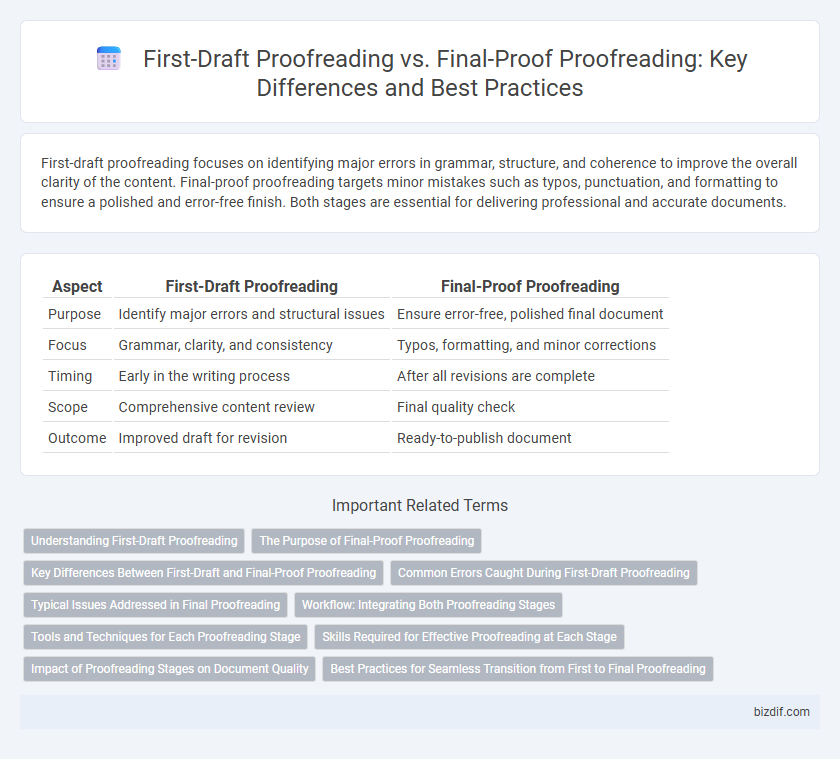First-draft proofreading focuses on identifying major errors in grammar, structure, and coherence to improve the overall clarity of the content. Final-proof proofreading targets minor mistakes such as typos, punctuation, and formatting to ensure a polished and error-free finish. Both stages are essential for delivering professional and accurate documents.
Table of Comparison
| Aspect | First-Draft Proofreading | Final-Proof Proofreading |
|---|---|---|
| Purpose | Identify major errors and structural issues | Ensure error-free, polished final document |
| Focus | Grammar, clarity, and consistency | Typos, formatting, and minor corrections |
| Timing | Early in the writing process | After all revisions are complete |
| Scope | Comprehensive content review | Final quality check |
| Outcome | Improved draft for revision | Ready-to-publish document |
Understanding First-Draft Proofreading
First-draft proofreading focuses on identifying broad errors such as structural inconsistencies, unclear arguments, and major grammatical mistakes to improve overall coherence and flow. It emphasizes spotting content gaps, sentence clarity, and logical transitions before refining finer details. This stage sets the foundation for polished writing by addressing significant issues early in the editing process.
The Purpose of Final-Proof Proofreading
Final-proof proofreading ensures all errors overlooked in earlier drafts are corrected, focusing on polishing grammar, punctuation, and formatting for publication readiness. It verifies consistency with style guides and confirms all corrections from previous drafts are accurately implemented. This stage is critical for delivering a flawless, professionally finished document.
Key Differences Between First-Draft and Final-Proof Proofreading
First-draft proofreading primarily targets structural issues, clarity, and major grammatical errors to shape the overall content, while final-proof proofreading focuses on eliminating minor typos, punctuation mistakes, and formatting inconsistencies for polish and precision. First-draft proofreading often involves substantial rewriting and content adjustments, whereas final-proof proofreading emphasizes accuracy and adherence to style guides. The key difference lies in their objectives: first-draft proofreading enhances content development, and final-proof proofreading ensures error-free perfection before publication.
Common Errors Caught During First-Draft Proofreading
First-draft proofreading primarily targets common errors such as typos, grammatical mistakes, inconsistent verb tenses, and incorrect word usage that can distort the clarity of the text. This stage often uncovers structural issues including awkward sentence construction and misplaced modifiers that disrupt flow and comprehension. Catching these errors early reduces the workload during final-proof proofreading, which focuses more on polishing punctuation, formatting consistency, and minor stylistic adjustments.
Typical Issues Addressed in Final Proofreading
Final-proof proofreading typically addresses issues such as typographical errors, formatting inconsistencies, and unresolved queries from earlier drafts. It ensures alignment with style guides, verifies pagination accuracy, and confirms the correctness of captions, references, and footnotes. By catchings these subtle errors, final proofreading enhances the overall clarity and professionalism of the completed document.
Workflow: Integrating Both Proofreading Stages
Integrating first-draft proofreading and final-proof proofreading streamlines the editorial workflow by separating structural revisions from surface error checks, increasing overall accuracy. First-draft proofreading targets content consistency, clarity, and logical flow, while final-proof proofreading ensures typographical, grammatical, and formatting precision before publication. Employing both stages reduces costly revisions, accelerates time-to-market, and enhances the quality of the final manuscript.
Tools and Techniques for Each Proofreading Stage
First-draft proofreading often employs tools like grammar checkers and style guides to catch broad errors in spelling, punctuation, and sentence structure, allowing for major content revisions. In contrast, final-proof proofreading relies heavily on manual line-by-line reading and specialized software such as track changes or PDF annotation tools to ensure precise correction of subtle typographical, formatting, and consistency issues. Each stage benefits from tailored techniques; early drafts require comprehensive editing tools to enhance clarity, while final proofs demand meticulous review methods and quality control software to guarantee publication-ready accuracy.
Skills Required for Effective Proofreading at Each Stage
First-draft proofreading requires keen attention to structural coherence, grammar accuracy, and content clarity, with a focus on identifying major errors and inconsistencies to guide substantial revisions. Final-proof proofreading demands meticulous skills in spotting typographical errors, punctuation mistakes, and formatting issues, ensuring the document is polished for publication or submission. Mastery in both stages involves understanding the distinct objectives and applying specialized techniques to enhance the overall quality of the text.
Impact of Proofreading Stages on Document Quality
First-draft proofreading targets major errors in grammar, structure, and clarity to establish a solid foundation for revision, significantly enhancing overall document coherence. Final-proof proofreading focuses on eliminating typos, formatting inconsistencies, and minor stylistic issues to ensure polished, professional presentation and accuracy. Implementing both stages of proofreading maximizes document quality by addressing different error types at optimal times during the writing process.
Best Practices for Seamless Transition from First to Final Proofreading
First-draft proofreading involves identifying major errors in content structure, grammar, and clarity to shape the overall document, while final-proof proofreading targets surface-level details like punctuation, spelling, and formatting consistency. Best practices for a seamless transition include maintaining detailed revision notes during the first draft, using version control tools to track changes, and implementing standardized style guides to ensure consistency. Effective communication between writers and proofreaders accelerates error resolution and enhances the document's quality across all proofreading stages.
First-draft proofreading vs Final-proof proofreading Infographic

 bizdif.com
bizdif.com